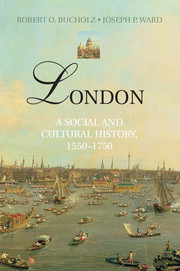Book contents
- Frontmatter
- Contents
- List of Illustrations and Maps
- List of Abbreviations and Conventions
- Acknowledgments
- Maps
- Introduction: London's Importance
- 1 London in 1550
- 2 The Socioeconomic Base
- 3 Royal and Civic London
- 4 Fine and Performed Arts
- 5 The Public Sphere and Popular Culture
- 6 The People on the Margins
- 7 Riot and Rebellion
- 8 Plague and Fire
- Conclusion: London in 1750
- Notes
- Further Reading
- Index
- Plate Section
7 - Riot and Rebellion
Published online by Cambridge University Press: 05 November 2012
- Frontmatter
- Contents
- List of Illustrations and Maps
- List of Abbreviations and Conventions
- Acknowledgments
- Maps
- Introduction: London's Importance
- 1 London in 1550
- 2 The Socioeconomic Base
- 3 Royal and Civic London
- 4 Fine and Performed Arts
- 5 The Public Sphere and Popular Culture
- 6 The People on the Margins
- 7 Riot and Rebellion
- 8 Plague and Fire
- Conclusion: London in 1750
- Notes
- Further Reading
- Index
- Plate Section
Summary
London liked to portray itself as a loyal, royal city, but also as the bastion of English liberties. It was that second description that worried the authorities. Quite simply, there were too many Londoners to control, and the city's wealth, size, location, and administrative importance ensured that it played a decisive role in the rise or fall of rulers and dynasties. No wonder that both the court at Whitehall and the Corporation at the Guildhall took alarm at even the hint of riot, let alone rebellion. The last chapter addressed how the authorities tried to maintain order, and how they reacted when individual Londoners violated that order. In particular, we noted the difficulties facing metropolitan governors who lacked a police force or any of the modern technology of surveillance or law enforcement. The regime was even more vulnerable to disorder when Londoners acted en masse, because the state had no standing army until the Civil Wars of the 1640s. From 1660 to 1685 the army was small and barely able to cope with localized rebellion; thereafter it was mostly away fighting continental wars and so unavailable for domestic security. In any case, Englishmen and women hated standing armies for the same reasons that they hated urban police forces: they were expensive and a threat to liberty.
Instead, during the reign of Henry VIII, London established a militia, the trained bands, which was easily the most formidable military force in England before 1650. Trained by the Artillery Company on the Artillery Ground just north of the ancient wall, they numbered at least 4,000 under Elizabeth I and expanded to 10,000 during the Civil Wars. The nine wartime regiments of trained bands distinguished themselves in the defense of London at Turnham Green in 1642 and the relief of Gloucester in 1643. But these amateur soldiers, shopkeepers, and tradesmen in their day jobs could not be relied on to fire at fellow Londoners. Indeed, the active enlistment of ordinary Londoners in their own policing as soldiers, constables, and watchmen seems to have promoted a sense of identification with, and ownership of, law and custom that ironically encouraged some of them to riot.
- Type
- Chapter
- Information
- LondonA Social and Cultural History, 1550–1750, pp. 268 - 308Publisher: Cambridge University PressPrint publication year: 2012



